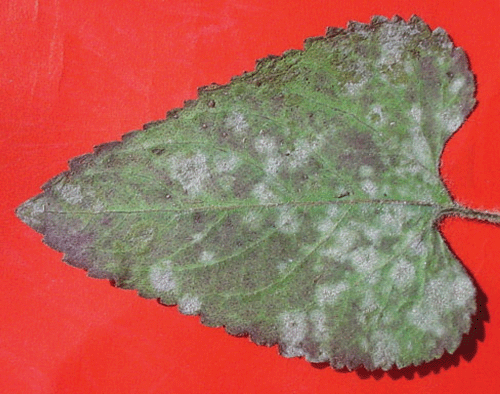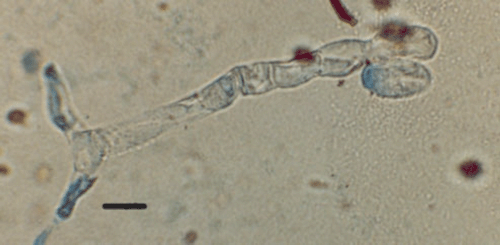First report of powdery mildew of Ageratum houstonianum in India
Pankaj Baiswar A B , Satish Chandra A and S. V. Ngachan AA ICAR Research Complex for NEH Region, Umiam 793103, Meghalaya, India.
B Corresponding author. Email: pbaiswar@yahoo.com
Australasian Plant Disease Notes 3(1) 48-49 https://doi.org/10.1071/DN08019
Submitted: 24 January 2008 Accepted: 5 April 2008 Published: 11 April 2008
Abstract
In November 2007, a severe outbreak of powdery mildew disease was observed on a weed species Ageratum houstonianum. Based on the morphological characters the pathogen was identified as a Podosphaera species. This is the first report of this organism causing powdery mildew on A. houstonianum in Meghalaya, India.
Ageratum houstonianum belongs to the Asteraceae, is native to South and Central America and extends as a common weed ~20° north and south of the equator (Johnson 1971). This species has been reported from 36 different crops in 46 countries (Holm et al. 1977; IRRI 1989). Ageratum species are also important as an alternate host of several economically important crop pathogens and nematodes. They are symptomless carriers of Pseudomonas solanacearum, bacterial wilt pathogen in India (Sunaina et al. 1989), some viruses (Logan et al. 1984) and of the root knot nematode, Meloidogyne javanica, in many parts of the world (Mamaril and Alberto 1989).
During November 2007, a severe outbreak of powdery mildew on A. houstonianum was observed in Barapani, Meghalaya, India. Powdery mildew symptoms were more severe on plants present in shady places. Disease symptoms included greyish white irregular patches consisting of epiphytic mycelia and conidia on both surfaces of the leaves (Fig. 1). Symptoms were also present on stems. Infected leaves later turned necrotic. A voucher specimen (HAL 2230 F.) has been deposited in Martin-Luther-Universität, Institut für Biologie, Bereich Geobotanik Herbarium, Germany.

|
Conidia were harvested by dislodging them from infected tissue onto a strip of clear tape, using a camel hairbrush. The tapes were mounted on microscopic slides (Correll et al. 1987). Morphological characteristics of the pathogen such as location of mycelia on the host, shape of appressoria, presence of dimorphic conidia, size and shape of conidia and branching of conidiophores were recorded. Hyphae were up to 4.6–6.4 μm wide with simple appressoria (sometimes nipple shaped). Conidiophores were mostly erect, 96.4–158.8 × 16.4–28.8 μm, the foot cells were 38.6–74.3 μm, conidia were cylindrical in shape, 28.2–37.4 × 12.2–18.6 μm, and produced in chains (Fig. 2). Fibrosin bodies were present in conidiophores and conidia. Based on these morphological characters the fungus was identified as a powdery mildew belonging to the genus Podosphaera (Cook et al. 1997). No perfect stage (chasmothecium) was found. Pathogenicity was confirmed by dusting conidia on healthy plants of A. houstonianum and non-inoculated plants served as controls. Inoculated plants developed symptoms after a week whereas control plants remained healthy.

|
To our knowledge, this is the first record of powdery mildew of A. houstonianum caused by a Podosphaera species in India. There is a possibility of involvement of this weed species as alternate host of powdery mildews infecting other plants.
Acknowledgements
The authors would like to thank Prof. Dr U. Braun for confirming the identity of the fungus. Authors are also grateful to Dr D.K. Hore for identification of Ageratum houstonianum.
Cook RTA,
Inman AJ, Billings C
(1997) Identification and classification of powdery mildew anamorphs using light and scanning electron microscopy and host range data. Mycological Research 101, 975–1002.
| Crossref | GoogleScholarGoogle Scholar |

Correll JC,
Gordon TR, Elliott VJ
(1987) Host range, specificity and biometrical measurements of Leveillula taurica in California. Plant Disease 71, 248–251.
| Crossref | GoogleScholarGoogle Scholar |

Johnson MF
(1971) A monograph of the genus Ageratum L. (Compositae-Eupatorieae). Annals of the Missouri Botanical Garden 58, 6–88.
| Crossref | GoogleScholarGoogle Scholar |

Logan AE,
Zettler FW, Christie SR
(1984) Susceptibility of Rudbeckia, Zinnia, Ageratum, and other bedding plants to Bidens mottle virus. Plant Disease 68, 260–262.
| Crossref | GoogleScholarGoogle Scholar |

Mamaril EC, Alberto RT
(1989) Root-knot nematodes infecting some common weeds in vegetable growing areas of Sicsican. International Nematology Network Newsletter 6, 37–39.

Sunaina V,
Kishore V, Shekhawat GS
(1989) Latent survival of Pseudomonas solanacearum in potato tubers and weeds. Zeitschrift fur Pflanzenkrankheiten und Pflanzenschutz 96, 361–364.



